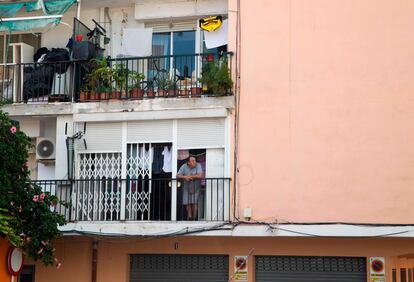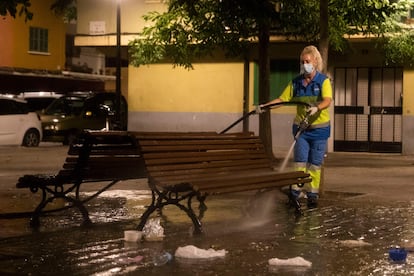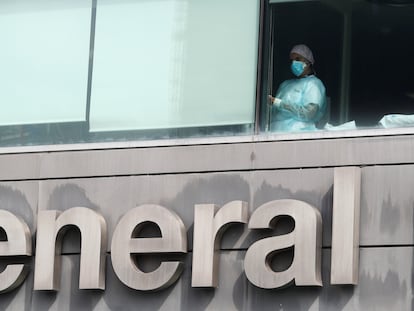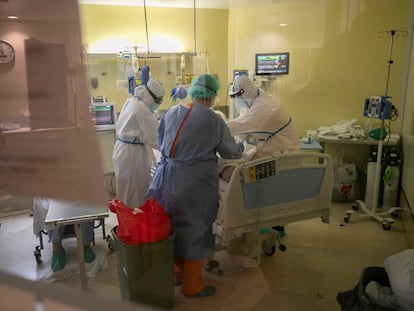What is a selective lockdown and how does it work?
EL PAÍS looks at how the rules were introduced in the Spanish city of Palma, in the Balearic Islands, following a spike in Covid-19 cases

Between August 1 and 25, the neighborhood of Son Gotleu, in the city of Palma in the Spanish island of Mallorca, had a coronavirus incidence rate of 7.28 cases per 1,000 inhabitants. It was by far the highest rate in the entire Balearic Islands, which also include the popular Ibiza. The epidemiological reports released during this period by the Balearic health department showed that the virus was spreading rapidly in the poorest areas of Palma, which at the time had an average incidence rate of 5.64 cases per 1,000 inhabitants.
The impact of the second Covid-19 wave on Son Gotleu ruined hopes that the pandemic could be contained in the middle of summer, and it led the Balearic regional government to adopt tighter restrictions. Last week, regional authorities ordered the selective lockdown of four neighborhoods in Palma, as well as different areas of Sant Antonio de Portmany and Ibiza city on Ibiza island.
What happened?
The 23,000 residents of Son Gotleu, Can Capes, La Soledat Nord and Son Canals, situated in the east of Palma, have been confined to a defined area – which is not physically marked in any way – since last Friday night. They are only allowed to leave the perimeter for essential business such as work, school and visits to the doctor. Capacity at shops and restaurants has been reduced by half, and social gatherings restricted to five people. Religious ceremonies and sporting activities have been suspended, and all stores have to close at 10pm.
It was not an easy decision to make, but it was necessary given the rising number of coronavirus cases in one of the most densely populated areas of the archipelago.
“Studying the data, we are able to locate contagions, even on a street-by-street level, and this allowed us to have a much more detailed evaluation of transmission in different areas,” explains Marga Frontera, who directs and coordinates the expert committee that has been advising the Balearic government during the deescalation process. “This information helped us adjust our response so that, as a first step, we could narrow down the perimeter as much as possible and allow the affected municipality to maintain activity as normally as possible.”

According to Frontera, the decision to partially confine four neighborhoods was based on the evolution of the disease in the area and specific “worrying” indicators, like the number of cases in the same building or home, which were seen in multiple instances and indicated possible community transmission of the virus. The measures limiting social gatherings and capacity at shops were introduced in a bid to reduce the number of contacts of each resident, and by doing so lower the risk of transmission. The restrictions will come to an end on Sunday, September 27, but may be extended if the situation has not improved.
“The measures are also aimed at reducing mobility, which we know helps the virus spread to other areas. That’s why we need people to limit their movements,” says Frontera.
The Balearic government is also considering measures for poorly-ventilated closed spaces, like gyms and religious sites, where many people gather without always wearing a face mask. “They are especially risky circumstances for contagion, especially for mass contagions, and that’s where we need to make more of an effort to restrict activity,” says Frontera.
How is it being enforced?
But who is making sure that no one is leaving the confinement area? The local council has tasked 20 local police officers with supervising these neighborhoods and issuing sanctions if violations are detected. In the first few days of the lockdown, this translated into fines for not wearing a face mask or for smoking in public spaces without respecting social distancing. The National Police department explains that they are available to enforce the rules of the Balearic health department, but do not currently have any fixed checkpoint and are conducting patrols as per usual.
This means that it is down to the individual to follow the measures and reduce transmission in Palma. Vicenç Alemany, the owner of Alemany pharmacy in Son Gotleu, thinks that this will be difficult in his neighborhood. “There are people who are very aware and worried about the issue, but I think it will be more difficult with youngsters,” says Alemany. “This is a complicated neighborhood because of social issues, and you have to explain the measures well to the people, because many of them don’t even know that things have changed.”
The lack of controls is also considered a problem by Jesús Heredia, a local from Son Gotleu, who says he has not seen more police officers in the neighborhood since it was confined. “Some [officers] drive by here in a patrol car but they don’t stop or do anything. I haven’t noticed any difference. There are people who follow [the measures], and others who go on the same as always. I know people who leave the neighborhood and nothing happens.”
The mayor of Palma, José Hila, says it’s up to individual residents to comply with the rules. “If we don’t want more areas confined, I am calling on the people, even if it is just those in these neighborhoods, to strictly follow the heath rules, which are more than clear. Only through individual responsibility will we defeat Covid-19. What the administration does is not enough,” he says, explaining that the measures “were necessary.”
I know people who leave the neighborhood and nothing happensJesús Heredia, local from Son Gotleu
“Citizens have to understand that these are the best measures that could be taken, and if they are not followed there will be consequences,” he warned, adding that 42 fines were issued on Tuesday for leaving the lockdown area.
The restrictions in Palma come as part of a bigger regional plan in which local government inspectors are tasked with informing businesses of the health rules and making sure they are met with the help of the police. “Door-to-door” visits to homes in the areas are also being done to make sure people are observing the confinement orders, and to find out what locals need in order to do so. From Friday, the same restrictions will be applied to the neighborhoods of Son Forteza Sur, Plaza de Toros, Archiduque and some streets in Son Olivia, restricting the mobility of 20,000 residents.
“If there is no sense of joint responsibility from the affected people, it will be difficult for it [the selective lockdown] to work, because obviously we cannot put up a physical perimeter in each area or a police officer behind each person,” says Frontera.
English version by Melissa Kitson.
Tu suscripción se está usando en otro dispositivo
¿Quieres añadir otro usuario a tu suscripción?
Si continúas leyendo en este dispositivo, no se podrá leer en el otro.
FlechaTu suscripción se está usando en otro dispositivo y solo puedes acceder a EL PAÍS desde un dispositivo a la vez.
Si quieres compartir tu cuenta, cambia tu suscripción a la modalidad Premium, así podrás añadir otro usuario. Cada uno accederá con su propia cuenta de email, lo que os permitirá personalizar vuestra experiencia en EL PAÍS.
¿Tienes una suscripción de empresa? Accede aquí para contratar más cuentas.
En el caso de no saber quién está usando tu cuenta, te recomendamos cambiar tu contraseña aquí.
Si decides continuar compartiendo tu cuenta, este mensaje se mostrará en tu dispositivo y en el de la otra persona que está usando tu cuenta de forma indefinida, afectando a tu experiencia de lectura. Puedes consultar aquí los términos y condiciones de la suscripción digital.
More information
Últimas noticias
NASA discovers Titan doesn’t have an ocean, but a ‘slushy ice layer’ that increases possibility of life
Innocence lost in the forest of the child soldiers: ‘Each leader of the armed group had his girls’
‘Fallout’ or how the world’s largest company turned an anti-capitalist apocalyptic Western into a phenomenon
From inflation to defending migrants: Eileen Higgins and Zohran Mamdani inaugurate the new Democratic resistance against Trump
Most viewed
- ‘El Limones’ and the growing union disguise of Mexican organized crime
- Christian Louboutin: ‘Young people don’t want to be like their parents. And if their parents wear sneakers, they’re going to look for something else’
- The low-cost creative revolution: How technology is making art accessible to everyone
- ‘We are dying’: Cuba sinks into a health crisis amid medicine shortages and misdiagnosis
- Liset Menéndez de la Prida, neuroscientist: ‘It’s not normal to constantly seek pleasure; it’s important to be bored, to be calm’











































